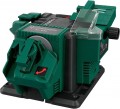Motor power
Rated power of the electric motor of the machine. The more powerful the engine, the higher the speed and intensity of processing can be, the larger discs can be used with the machine and the better it is suitable for working with hard, stubborn materials. On the other hand, a powerful motor consumes a lot of energy (which may require special connection — see "Power") and significantly affects the dimensions, weight and price of the entire unit. Therefore, manufacturers choose this parameter based on the type (see "Machine") and the desired characteristics of speed, productivity, etc. In fact, this means that engine power is rather a secondary parameter, and when choosing, it makes sense to pay attention to more practical points — disk diameter, rotation / movement speed, etc.
Bore diameter
The bore diameter of the dry cutting discs (see above) used by the machine. In order for the nozzle to be used normally with the machine, it must match it not only in diameter and thickness (see the relevant paragraphs), but also in the size of the mounting hole.
Flexible shaft (engraver)
The presence
of a flexible shaft with an engraver in the design of the machine. Such a device can be described as an engraving machine connected to the machine with a flexible "wire" — however, not electricity is transmitted through this wire, but rotation from the machine's engine. Thus, by purchasing such a model, the user receives a 2 in 1 unit. At the same time, the power delivered to the engraver is often higher than that of manual models, because. the movement is provided not by the built-in compact motor, but by the heavy stationary electric motor of the machine.
This feature is found mainly in grinding and polishing models (see "Machine"), originally designed for fairly delicate work.

